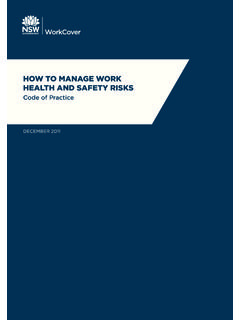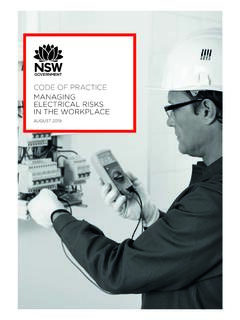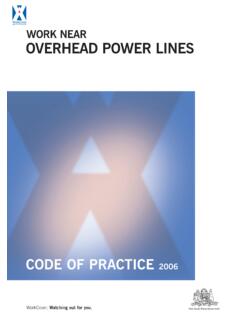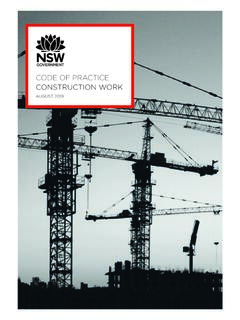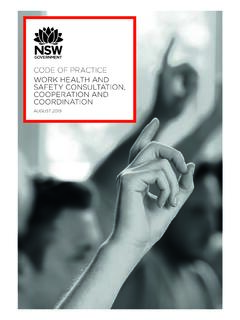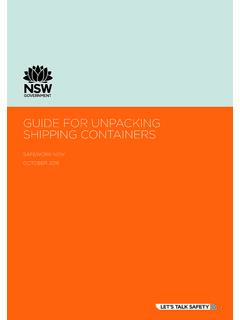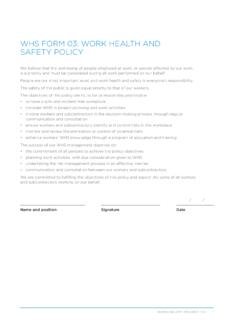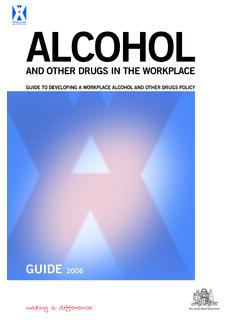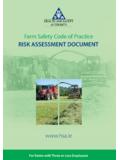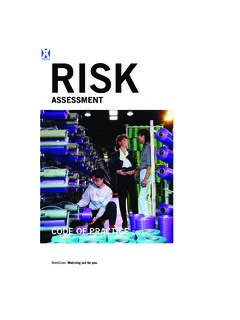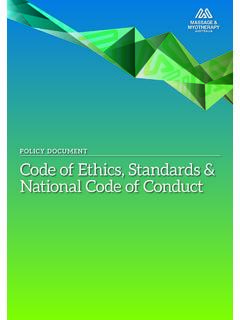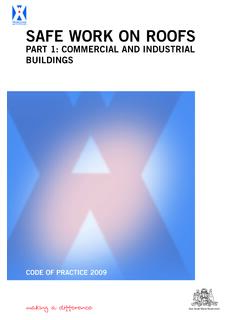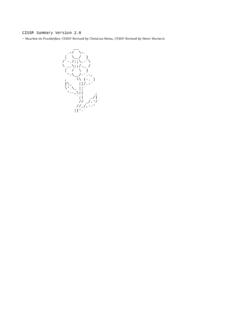Transcription of Code of Practice – Demolition work
1 code OF PRACTICEDEMOLITION WORKAUGUST 2019 NSW note: This code is based on a national model code of Practice developed by Safe Work Australia under the harmonisation of national work health and safety legislation and has been approved under section 274 of the NSW Work Health and Safety Act 2011. Notice of that approval was published in the NSW Government Gazette referring to this code of Practice as Demolition work (page 2695) on Friday, 18 July 2014. This code of Practice commenced on Friday, 18 July amendments under section 274 of the NSW Work Health and Safety Act 2011 have been published and commenced as detailed in the list of amendments contained in this for the NSW Government logo, this copyright work is licensed under a Creative Commons Attribution-Non-Commercial Australia view a copy of this licence, visit are free to copy, communicate and adapt the work for non-commercial purposes, as long as you attribute the work to SafeWork NSW and abide by the other licence terms.
2 Demolition work code of Practice Page 3 of 59 Contents Foreword .. 5 1. Introduction .. 6 What is Demolition work? .. 6 Who has health and safety duties in relation to Demolition work? .. 6 What is involved in managing risks associated with Demolition work? .. 9 Information, training, instruction and supervision .. 12 2. The risk management process .. 14 Identifying the hazards .. 14 Assessing the risks .. 15 Controlling the risks .. 16 Maintaining and reviewing control measures .. 17 3. Planning the Demolition work .. 18 Notifiable Demolition work .. 18 Principal contractor for a construction project .. 19 Designers .. 20 Safe Work Method Statements .. 21 Demolition licensing .. 22 Asbestos licensing .. 23 Adjacent or adjoining buildings.
3 24 Essential services .. 24 4. Controlling risks in Demolition work .. 27 The building or structure to be demolished .. 27 Hazardous chemicals and materials .. 27 Securing the work area .. 31 Emergency plan .. 32 Plant and equipment .. 33 Powered mobile plant .. 34 Removal of debris .. 34 Falls .. 35 Electricity .. 36 Fire prevention .. 36 Manual Demolition .. 37 Demolition work code of Practice Page 4 of 59 Mechanical Demolition .. 40 Induced collapse .. 42 Using explosives .. 43 5. Controlling risks when demolishing special structures .. 45 Pre and post-tensioned concrete .. 45 Fire-damaged, ruinous and structurally unsound buildings or structures .. 46 Lift shafts .. 46 Basements, cellars, vaults, domes and arched roofs.
4 46 Masonry and brick arches .. 47 Independent chimneys and spires .. 47 Pylons and masts .. 48 Precast concrete panels .. 48 Facade retention .. 48 Storage tanks and pipelines .. 48 Appendix A Glossary .. 50 Appendix B Demolition plan .. 55 Appendix C Engineering investigation considerations .. 56 Appendix D References and other information sources .. 57 Amendments .. 58 Demolition work code of Practice Page 5 of 59 Foreword This code of Practice on how to manage the risks associated with Demolition work is an approved code of Practice under section 274 of the Work Health and Safety Act (the WHS Act). An approved code of Practice provides practical guidance on how to achieve the standards of work health and safety required under the WHS Act and the Work Health and Safety Regulation (the WHS Regulation) and effective ways to identify and manage risks .
5 A code of Practice can assist anyone who has a duty of care in the circumstances described in the code of Practice . Following an approved code of Practice will assist the duty holder to achieve compliance with the health and safety duties in the WHS Act and WHS Regulation, in relation to the subject matter of the code of Practice . Like regulations, codes of Practice deal with particular issues and may not cover all relevant hazards or risks . The health and safety duties require duty holders to consider all risks associated with work, not only those for which regulations and codes of Practice exist. Codes of Practice are admissible in court proceedings under the WHS Act and WHS Regulation. Courts may regard a code of Practice as evidence of what is known about a hazard, risk, risk assessment or risk control and may rely on the code in determining what is reasonably practicable in the circumstances to which the code of Practice relates.
6 For further information see the Interpretive Guideline: The meaning of reasonably practicable . Compliance with the WHS Act and WHS Regulation may be achieved by following another method, if it provides an equivalent or higher standard of work health and safety than the code . An inspector may refer to an approved code of Practice when issuing an improvement or prohibition notice. Scope and application This code is intended to be read by a person conducting a business or undertaking (PCBU). It provides practical guidance to PCBUs on how to manage health and safety risks associated with Demolition work. The guidance in this code is relevant to Demolition contractors as well as PCBUs who have management or control of workplaces where excavation work is carried out, for example principal contractors.
7 This code may be a useful reference for other persons interested in the duties under the WHS Act and WHS Regulation. This code applies to all workplaces covered by the WHS Act where Demolition work is carried out and where Demolition work products and equipment are used and stored. Persons who have duties in relation to Demolition work should also refer to the code of Practice : Construction work. How to use this code of Practice This code includes references to the legal requirements under the WHS Act and WHS Regulation. These are included for convenience only and should not be relied on in place of the full text of the WHS Act or WHS Regulation. The words must , requires or mandatory indicate a legal requirement exists that must be complied with. The word should is used in this code to indicate a recommended course of action, while may is used to indicate an optional course of action.
8 Demolition work code of Practice Page 6 of 59 1. Introduction What is Demolition work? Demolition work means work to demolish or dismantle a structure or part of a structure that is load-bearing or otherwise related to the physical integrity of the structure, but does not include: - the dismantling of formwork, falsework, scaffolding or other structures designed or used to provide support, access or containment during construction work, or - the removal of power, light or telecommunication poles. A structure is anything that is constructed, whether fixed or moveable, temporary or permanent, and includes buildings, sheds, towers, chimney stacks, silos, storage tanks. Demolition work is a type of construction work . Therefore, when carrying out Demolition work, the requirements relating to construction work must also be complied with.
9 Demolition work is also high risk construction work if it involves Demolition of an element of a structure that is load-bearing or otherwise related to the physical integrity of the structure. A Safe Work Method Statement (SWMS) must be prepared before the high risk construction work starts. Further guidance on SWMS is available in section of this code . Further guidance on construction work and high risk construction work duties is available in the code of Practice : Construction work. Other key terms relating to Demolition work are listed in Appendix A. Who has health and safety duties in relation to Demolition work? Duty holders who have a role in managing the risks of Demolition work include: - persons conducting a business or undertaking (PCBUs) - designers, manufacturers, importers, suppliers and installers of plant, substances or structures, and - officers.
10 Workers and other persons at the workplace also have duties under the WHS Act, such as the duty to take reasonable care for their own health and safety at the workplace. A person can have more than one duty and more than one person can have the same duty at the same time. Early consultation and identification of risks can allow for more options to eliminate or minimise risks and reduce the associated costs. The main duties in relation to managing the risks of Demolition work are set out in Chapter 2. Person conducting a business or undertaking WHS Act section 19 Demolition work code of Practice Page 7 of 59 Primary duty of care A PCBU must eliminate risks arising from Demolition work, or if that is not reasonably practicable, minimise the risks so far as is reasonably practicable.
